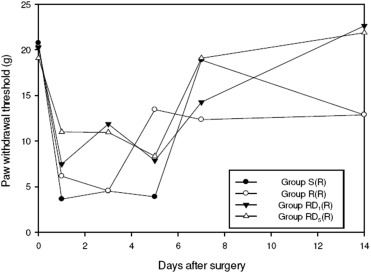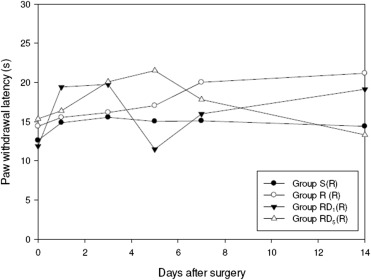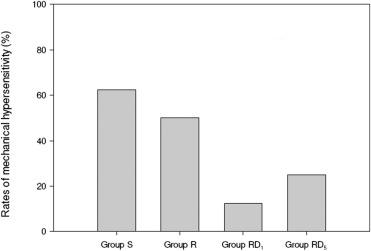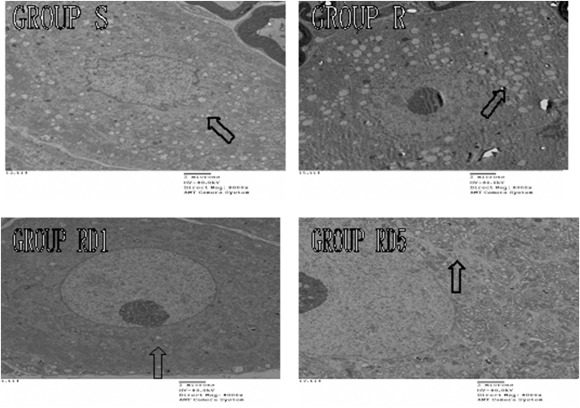Summary
Background
Dexmedetomidine has been proposed as a novel anesthetic adjuvant. However, it remains unclear whether peripheral administration of dexmedetomidine is safe and effective to reduce acute postoperative pain. This study aimed to examine the effects of dexmedetomidine on neuropathic pain.
Methods
Adult male Sprague-Dawley rats were anaesthetized and randomly allocated into four groups (n = 8): Groups S, R, RD1, and RD5 were injected with saline, 0.5% ropivacaine, 0.5% ropivacaine combined with 1 μg dexmedetomidine, and 0.5% ropivacaine combined with 5 μg dexmedetomidine, respectively, around the saphenous nerve. Then, the rats were subjected to skin/muscle incision and retraction (SMIR) surgery in the medial thigh. Mechanical and heat sensitivity was evaluated and morphology of the dorsal root ganglion (DRG) neurons was observed by electron microscopy.
Results
Some 62.5%, 50%, 12.5%, and 25% of rats developed mechanical hypersensitivity in Groups S, R, RD1, and RD5, respectively. The number of swollen mitochondria in DRG neurons was significantly more in Group S (257.2 ± 60.9) and Group R (291.6 ± 82.1) than in Group RD1 (97.2 ± 33.3) and Group RD5 (13.6 ± 17.9). In addition, the edema in endoplasmic reticulum and Golgi apparatus was decreased in Group RD1 and Group RD5 compared with Group S and Group R.
Conclusion
Peripheral administration of dexmedetomidine improves mechanical and heat hyperalgesia and mitigates postoperative pain.
Keywords
dexmedetomidine;dorsal root ganglion neuron;postoperative pain;ropivacaine;skin/muscle incision and retraction
1. Introduction
Open inguinal hernia repair is one of the most painful procedures in surgery because it involves essential prolonged tissue retraction and often causes persistent postoperative pain. Local anesthetic into the retraction site can reduce the postoperative pain and reduce the dosage of morphine, which can prolong the first usage of morphine.1 ; 2 Since the clinical introduction of ropivacaine, its safety in the central nervous and cardiovascular systems compared with bupivacaine has attracted attention.3 Ropivacaine is also widely used for infiltration anesthesia in Europe.4; 5 ; 6 However, the local pharmacokinetics of ropivacaine show that the effects of infiltration anesthesia with ropivacaine on the dental pulp are not as strong as expected, because it has a high affinity for soft tissue.6 To compensate for this weakness, clinical practitioners favored adding some adjuvants to ropivacaine.
A recent study showed that local injection of a novel α2 receptor agonist dexmedetomidine enhanced the local anesthetic potency of lidocaine via the α2A adrenoceptor subtype in guinea pigs; dexmedetomidine at a concentration of 1μM induced peripheral vasoconstriction without a systemic cardiovascular response via the peripheral α2A adrenoceptor subtype.7
The nerve endings of dorsal root ganglion (DRG) neurons have a variety of sensory receptors that are activated by mechanical, thermal, chemical, and noxious stimuli. The changes in structure and gene expression in DRG neurons appear to contribute to the development of neuropathic pain. However, no study has shown whether the peripheral administration of dexmedetomidine is safe and effective for reducing acute postoperative pain. In addition, the effects of dexmedetomidine on substructural changes in DRG neurons remain unclear. This study aimed to investigate the effects of dexmedetomidine on neuropathic pain after inguinal hernia repair surgery. To mimic the clinical scenario, a model of skin/muscle incision and retraction (SMIR) in the medial thigh has been established to evoke persistent postoperative pain. In this study, we used the SMIR model to examine the effects of dexmedetomidine on neuropathic pain and substructures in DRG neurons.
2. Materials and methods
2.1. Animals
Adult male Sprague-Dawley rats (200–300 g) were housed in pairs in plastic cages. Artificial lighting was provided on a fixed 12:12 hour light/dark cycle (7:00 AM light on) with free access to food and water. This study was conducted based on the recommendations in the Guide for the Care and Use of Laboratory Animals of the National Institutes of Health. Animal studies were approved by the Animal Care and Use Committee of Southern Medical University.
2.2. Surgery procedures
Rats were anaesthetized with i.p. 10% chloral hydrate (100 mg/mL) at dose of 400 mg/kg, laid on their back, and the medial thigh on one side was shaved. The shaved skin was then swabbed with sterile alcohol wipes for the sterilization and visualization of the saphenous vein. The rats were randomly allocated into four groups (n = 8): Group R was injected with 0.5% ropivacaine around the saphenous nerve; Group RD1 was injected with 0.5% ropivacaine combined with 1 μg dexmedetomidine around the saphenous nerve; Group RD5 was injected with 0.5% ropivacaine combined with 5 μg dexmedetomidine around the saphenous nerve; and Group S was injected with 0.9% saline around the saphenous nerve.
An incision of 1.5–2 cm was made in the skin of the medial thigh approximately 4 mm medial to the saphenous vein. An incision (7–10 mm long) was then made in the superficial (gracilis) muscle layer of the thigh, approximately 4 mm medial to the saphenous nerve. The superficial muscle was then parted further, by spreading blunt scissors within the muscle incision site, to allow the insertion of a micro dissecting retractor. The retractor had four prongs spaced over 8 mm and each prong was 4 mm deep (Cat. No. 13-1090, Biomedical Research Instruments Inc., Silver Spring, MD, USA). The retractor was inserted into the incision site, to position all prongs underneath the superficial layer of thigh muscle. The skin and superficial muscle of the thigh were then retracted by 2 cm and the retraction was maintained for 1 hour. During the retraction, the saphenous nerve was displaced and potentially stretched around the retractor. The animals were monitored during the retraction period and if required, additional anesthesia was provided using chloral hydrate. During the retraction period, animals were completely covered (apart from the top of the head) with a large absorbent bench underpad to minimize heat loss and prevent dehydration of the surgical site. Following the SMIR procedure, the muscle and skin of the surgical site was closed with silk 3.0 and 4.0 Vicryl sutures, respectively. Sham-operated rats underwent the same procedure with the exception of the skin/muscle retraction. Following recovery from anesthesia, all animals could rise up on their hindpaws to reach food and water.
2.3. Assessment of mechanical sensitivity
Mechanical sensitivity was assessed using the up-down method as described previously.8 Briefly, rats were placed inside acrylic cages on a wire mesh grid floor. The probe was applied to the middle of the left hind paw to determine the stimulus intensity threshold stiffness. Quick withdrawal in response to the stimulus was considered to be a positive response.
2.4. Assessment of heat sensitivity
Animals were placed in individual Perspex boxes on a glass floor. Nociceptive responses to a noxious heat stimulus were examined by measuring the hindpaw withdrawal latency from a focused beam of radiant heat to the plantar surface (Ugo Basile plantar test apparatus, Monvalle, Italy). The withdrawal latency to this stimulus was measured in seconds and the apparatus had a build-in cut-off latency of 31.2 seconds. Both hindpaws of each rat were tested three times and then an average of these three readings taken. To avoid sensitization of the paws, several minutes had elapsed before the same hindpaw was retested.
2.5. General toxicity
Body weights were measured before each injection and behavioral assessments. All rats were examined daily for piloerection, alopecia, fecal abnormalities, and diet situation.
2.6. Transmission electron microscopy
At the end of the experiments, the rats were killed and DRGs were dissected. DRGs were cut into sections and fixed in 2.5% glutaraldehyde in 0.01 mol/L phosphate buffer, followed by 2% osmium tetroxide. Next, the sections were dehydrated in a series of graded ethanol solutions and embedded in epoxy resin. Ultrathin sections were double-stained with uranyl acetate and lead, and examined under a JEM1200EX transmission electron microscope (Jeol, Tokyo, Japan).
2.7. Statistical analysis
Data were expressed as the mean ± standard deviation and analyzed using SPSS version 12 statistical analysis package (SPSS Inc., Chicago, IL, USA). A p value < 0.05 was accepted as statistically significant.
3. Results
3.1. Assessment of general condition
All rats regularly received four injections as described and no animals died during the experiments. Furthermore, no recession in motor activity was observed and no abnormal clinical symptoms such as alopecia, anorexia, and diarrhea were observed. All rats continued to gain weight steadily, and no significant differences in the weight were observed among the groups.
3.2. Assessment of mechanical sensitivity
For the mechanical sensitivity test, no significant differences existed among the groups at baseline (Figure 1). However, SMIR group rats had pronounced and prolonged mechano-hyperalgesia after the first injection compared with the other three groups. Group R, Group RD1, and Group RD5 rats had milder and shorter pain behaviors than Group S within the study period. In Group S, mechano-hyperalgesia was obvious from Day 1 and lasted until Day 5 (Figure 1). In Group R and Group RD1, mechano-hyperalgesia was obvious from Day 1 and lasted until Day 3. In Group RD5, mechano-hyperalgesia was obvious from Day 1, peaked at Day 5, and lasted until Day 5 (Figure 1). The detailed data of mechanical pain threshold of the four groups are listed in Table 1.
|
|
|
Figure 1. Mechanical pain threshold of four groups. Ipsilateral paw response to von Frey stimulation was severe in Group S compared with Group R and RD1 during the postoperative time course, and it was significantly milder in Group RD1 and RD5 than in the other two groups at Day 14. Group RD1 was injected with 0.5% ropivacaine combined with 1 μg dexmedetomidine. Group RD5 was injected with 0.5% ropivacaine combined with 5 μg dexmedetomidine. Group S was injected with 0.9% saline before surgery. Group R was injected with 0.5% ropivacaine. |
| Group (n = 8) | D0 | D1 | D3 | D5 | D7 | D14 |
|---|---|---|---|---|---|---|
| Group S | 20.30 ± 1.20 | 3.64 ± 0.59 | 4.52 ± 0.67 | 3.89 ± 0.88 | 18.89 ± 0.27 | 12.88 ± 0.34 |
| Group R | 20.24 ± 0.42 | 6.15 ± 5.90* | 5.83 ± 0.73 | 13.46 ± 0.24 | 12.36 ± 0.34* | 12.43 ± 0.47 |
| Group RD1 | 20.14 ± 0.40 | 7.48 ± 3.30* | 7.48 ± 0.33* | 7.87 ± 0.34 | 14.27 ± 0.46 | 22.64 ± 0.68* |
| Group RD5 | 21.25 ± 0.44 | 11.00 ± 3.80* | 10.96 ± 0.58* | 8.36 ± 0.82 | 25.37 ± 0.47* | 21.88 ± 0.23* |
- p < 0.05 versus Group S.
3.3. Assessment of heat sensitivity
For the heat sensitivity test, no significant differences existed among the groups at baseline (Figure 2). The rats in Group S showed no significant changes in heat sensitivity throughout the experimental period. The response latency of group RD1 rats increased significantly from Day 1 until Day 3, while that of group RD5 rats increased significantly from Day 3 to Day 5 (Figure 2). We found no significant difference in response latency between Group S and the other three groups at other time points (Figure 2, Table 2).
|
|
|
Figure 2. Heat pain latency of four groups. Ipsilateral paw response to heat was delayed in Groups R, RD1, and RD5 compared with Group S. Group RD1 was injected with 0.5% ropivacaine combined with 1 μg dexmedetomidine. Group RD5 was injected with 0.5% ropivacaine combined with 5 μg dexmedetomidine. Group S was injected with 0.9% saline before surgery. Group R was injected with 0.5% ropivacaine. |
| Group (n = 8) | D0 | D1 | D3 | D5 | D7 | D14 |
|---|---|---|---|---|---|---|
| Group S | 13.13 ± 0.16 | 15.93 ± 0.43 | 16.64 ± 0.77 | 15.02 ± 0.79 | 15.09 ± 0.18 | 14.39 ± 0.34 |
| Group R | 13.64 ± 0.21 | 14.60 ± 0.72 | 15.24 ± 0.81 | 17.03 ± 0.16 | 20.01 ± 0.35 | 21.17 ± 0.45* |
| Group RD1 | 13.09 ± 0.69 | 20.09 ± 0.36* | 20.33 ± 0.31* | 11.46 ± 0.21 | 15.97 ± 0.28 | 19.13 ± 0.61* |
| Group RD5 | 13.09 ± 0.23 | 18.86 ± 0.31 | 21.96 ± 0.59* | 21.34 ± 0.53* | 17.91 ± 0.32 | 17.29 ± 0.28 |
- p < 0.05 versus Group S.
3.4. Evaluation of persistent pain
In this study, five out of a total of eight SMIR-operated rats generated mechanical hypersensitivity compared with baseline, indicating that 62.5% of rats in Group S developed mechanical hypersensitivity at the end of the observational day (14 days after surgery). In comparison, 50% of rats in Group R developed mechanical hypersensitivity, which showed no statistical difference from Group S. In RD1 and RD5 groups, about 12.5% and 25% of rats developed mechanical hypersensitivity, respectively (Figure 3, Table 3, p < 0.05 compared with Group S).
|
|
|
Figure 3. Rates of mechanical hypersensitivity of four groups. Some 62.5% rats developed evoked mechanical hypersensitivity in Group S, 50% rats developed evoked mechanical hypersensitivity in Group R, 12.5% rats developed evoked mechanical hypersensitivity in Group RD1, and 25% rats developed evoked mechanical hypersensitivity in Group RD5. Group R was injected with 0.5% ropivacaine before every incision was made. Group RD1 was injected with 0.5% ropivacaine combined with 1 μg dexmedetomidine. Group RD5 was injected with 0.5% ropivacaine combined with 5 μg dexmedetomidine. Group S was injected with 0.9% saline before surgery. Group R was injected with 0.5% ropivacaine. |
| Group S | Group R | Group RD1 | Group RD5 | |
|---|---|---|---|---|
| Rate | 62.5% | 50% | 12.5%* | 25%* |
| Value below baseline | 5 | 4 | 1 | 2 |
- p < 0.05 versus Group S.
3.5. Subcellular structure of DRG
By transmission electron microscopy, we found that the number of swollen mitochondria in DRG was significantly more in Group S (257.2 ± 60.9) and Group R (291.6 ± 82.1) than in Group RD1 (97.2 ± 33.3) and Group RD5 (13.6 ± 17.9). In addition, the edema in endoplasmic reticulum and Golgi apparatus was decreased in Group RD1 and Group RD5 compared with Group S and Group R (Figure 4).
|
|
|
Figure 4. Subcellular structure of dorsal root ganglion (DRG) neurons. The swelling of the mitochondria and the edema of endoplasmic reticulum and Golgi apparatus were decreased in Group RD1 and Group RD5 versus Group S and Group R. Original magnification: 8000 ×. Arrows indicated swollen mitochondria. Group R was injected with 0.5% ropivacaine before every incision was made. Group RD1 was injected with 0.5% ropivacaine combined with 1 μg dexmedetomidine. Group RD5 was injected with 0.5% ropivacaine combined with 5 μg dexmedetomidine. Group S was injected with 0.9% saline before surgery. Group R was injected with 0.5% ropivacaine. |
4. Discussion
The SMIR model is a novel rat model of persistent postoperative pain evoked by SMIR, very similar to a clinical procedure. SMIR-operated rats exhibited at least 3 weeks of hypersensitivity to mechanical stimulation to the plantar ipsilateral paw, but SMIR surgery did not evoke mechanical hypersensitivity in the contralateral paw. The SMIR model is reproducible, with a high proportion of animals operated over a 10 month period developing SMIR-evoked pain. Flatters9 demonstrated that SMIR surgery did not induce significant peripheral neuronal damage, suggesting that nerve damage is not a causal factor in persistent postoperative pain evoked by SMIR.
α2 Adrenergic activation leads to analgesic effects. Dexmedetomidine is an α2 adrenergic agonist that binds to α2 adrenergic receptors in the central nervous system and the spinal cord, and it also binds to imidazoline receptors in the brain.10 However, the analgesic effect of dexmedetomidine added to ropivacaine was not reversed by α1 and α2 adrenoceptor antagonists.11 Dexmedetomidine has been administered by various routes as the adjuvant to reduce postoperative pain, such as via the oral, intravenous, transdermal, intrathecal, and epidural routes.12 ; 13 However, there is no study on the long-term effect of ropivacaine combined with dexmedetomidine. In the current model, we evaluated the mechanical and thermal sensitivity of the rats, and our results showed that dexmedetomidine could strengthen the analgesic effect of ropivacaine and tremendously reduce postoperative pain when administered in peripheral nerve blocks. In addition, no motor activity and abnormal clinical manifestations were observed in the rats, and all rats gained weight steadily and similarly to Group S.
Several studies have shown that the addition of dexmedetomidine accentuated the analgesic efficacy of locally administered ropivacaine.1; 2 ; 3 Consistent with these studies, we found that the time to first peak of minimal paw withdrawal latency was delayed in combined dosage groups, and paw withdrawal latency was increased in Group RD1 and Group RD5.
Mitochondrial abnormality has been associated with pain.14 To understand the detailed substructure changes in DRG after SMIR, we employed electron microscopy and observed atypical swollen mitochondria in the ipsilateral paw in the SMIR group. It was hypothesized that paclitaxel binds to axonal mitochondria and causes mitochondrial permeability transition pores (mPTPs) to open and release intracellular calcium. Such an increase in intracellular calcium promotes neuronal hyperexcitability, resulting in pain behavior.14In vivo recordings have revealed spontaneous activity in peripheral nociceptive fibers of paclitaxel-treated rats and calcium-chelating agents inhibited paclitaxel-induced pain. 15 ; 16 Swollen and vacuolated mitochondria have been observed in the nerves of patients with painful peripheral neuropathy induced by 2′3′-dideoxycytidine.17 Furthermore, mitochondrial abnormality in sensory axons in paclitaxel-evoked painful peripheral neuropathy contributed to sensory dysfunction in the rats.18 Therefore, management of mitochondria abnormality might be a novel approach for pain control. In the present study, simple administration of ropivacaine could not reverse the subcellular structure change such as atypical mitochondria of DRG in the SMIR model within 3 days. However, ropivacaine combined with a different dosage of dexmedetomidine markedly decreased mitochondrial abnormality, such as the number of swollen mitochondria and the level of swelling in the mitochondria. In our future study, we will collect DRGs at earlier stage to observe mitochondrial abnormality associated with pain in acute state.
In conclusion, the addition of dexmedetomidine to locally administered ropivacaine improves analgesia in the acute postoperative period in SMIR surgery.
References
- 1 F. Torun, C. Mordeniz, Z. Baysal, et al.; Intraoperative perineural infiltration of lidocaine for acute postlaminectomy pain: preemptive analgesia in spinal surgery; J Spinal Disord Tech, 23 (2010), pp. 43–46
- 2 F.W. Abdallah, J.G. Laffey, S.H. Halpern, R. Brull; Duration of analgesic effectiveness after the posterior and lateral transversus abdominis plane block techniques for transverse lower abdominal incisions: a meta-analysis; Br J Anaesth, 111 (2013), pp. 721–735
- 3 T.G. Hansen; Ropivacaine: a pharmacological review; Expert Rev Neurother, 4 (2004), pp. 781–791
- 4 D. Kanagia, S. Fotiadis, G. Tripsiannis; Comparative efficacy of ropivacaine and bupivacaine infiltrative analgesia in otoplasty; Ann Plast Surg, 54 (2005), pp. 409–411
- 5 B. Johansson, B. Hallerbäck, A. Stubberöd, et al.; Preoperative local infiltration with ropivacaine for postoperative pain relief after inguinal hernia repair. A randomised controlled trial; Eur J Surg, 163 (1997), pp. 371–378
- 6 M.F. Mulroy, F.W. Burgess, B.M. Emanuelsson; Ropivacaine 0.25% and 0.5%, but not 0.125%, provide effective wound infiltration analgesia after outpatient hernia repair, but with sustained plasma drug levels; Reg Anesth Pain Med, 24 (1999), pp. 136–141
- 7 A. Yabuki, H. Higuchi, T. Yoshitomi, et al.; Locally injected dexmedetomidine induces vasoconstriction via peripheral α-2A adrenoceptor subtype in guinea pigs; Reg Anesth Pain Med, 39 (2014), pp. 133–136
- 8 I.E. Bonilla, K. Tanabe, S.M. Strittmatter; Small proline-rich repeat protein 1A is expressed by axotomized neurons and promotes axonal outgrowth; J Neurosci, 22 (2002), pp. 1303–1315
- 9 S.J. Flatters; Characterization of a model of persistent postoperative pain evoked by skin/muscle incision and retraction (SMIR); Pain, 135 (2008), pp. 119–130
- 10 Z.P. Khan, C.N. Ferguson, R.M. Jones; Alpha-2 and imidazoline receptor agonists. Their pharmacology and therapeutic role; Anaesthesia, 54 (1999), pp. 146–165
- 11 C.M. Brummett, E.K. Hong, A.M. Janda, F.S. Amodeo, R. Lydic; Perineural dexmedetomidine added to ropivacaine for sciatic nerve block in rats prolongs the duration of analgesia by blocking the hyperpolarization-activated cation current; Anesthesiology, 115 (2011), pp. 836–843
- 12 T. Maruta, T. Nemoto, S. Satoh, et al.; Dexmedetomidine and clonidine inhibit the function of NaV1.7 independent of a2-adrenoceptor in adrenal chromaffin cells; J Anesth, 25 (2011), pp. 549–557
- 13 K. Axelsson, A. Gupta; Local anaesthetic adjuvants: neuraxial versus peripheral nerve block; Curr Opin Anaesthesiol, 22 (2009), pp. 649–654
- 14 S.J. Flatters, G.J. Bennett; Studies of peripheral sensory nerves in paclitaxel-induced painful peripheral neuropathy: evidence for mitochondrial dysfunction; Pain, 122 (2006), pp. 245–257
- 15 W. Xiao, L. Naso, G.J. Bennett; Experimental studies of potential analgesics for the treatment of chemotherapy-evoked painful peripheral neuropathies; Pain Med, 9 (2008), pp. 505–517
- 16 C. Siau, G.J. Bennett; Dysregulation of cellular calcium homeostasis in chemotherapy-evoked painful peripheral neuropathy; Anesth Analg, 102 (2006), pp. 1485–1490
- 17 M.C. Dalakas, C. Semino-Mora, M. Leon-Monzon; Mitochondrial alterations with mitochondrial DNA depletion in the nerves of AIDS patients with peripheral neuropathy induced by 2′3′-dideoxycytidine (ddC); Lab Invest, 81 (2001), pp. 1537–1544
- 18 W.H. Xiao, H. Zheng, F.Y. Zheng, et al.; Mitochondrial abnormality in sensory, but not motor, axons in paclitaxel-evoked painful peripheral neuropathy in the rat; Neuroscience, 199 (2011), pp. 461–469
Document information
Published on 26/05/17
Submitted on 26/05/17
Licence: Other
Share this document
Keywords
claim authorship
Are you one of the authors of this document?



